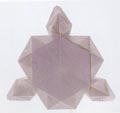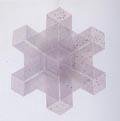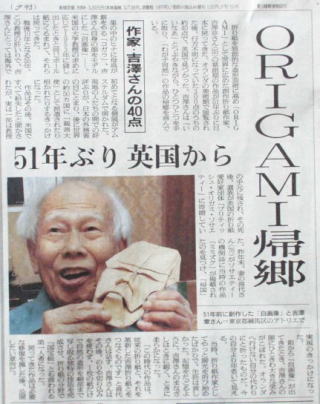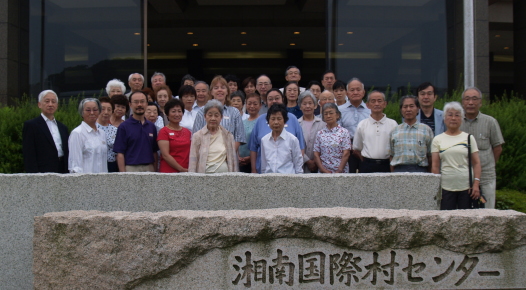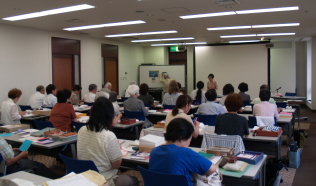 |
| Participants studied how to fold gMantah and attach to panels. |
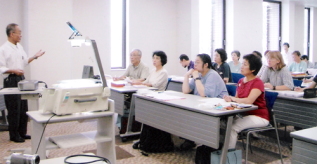 |
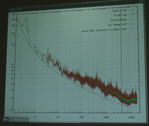
We invited Prof. Izumi Kimura as a guest lecturer for special session.
With a detailed graph, he explained his unique research folding Yoshizawafs
gWrenh about 160,000 times for more than 10 years and collected all data.
He would continue this research from now on. |
The Power Law of Practice
by Prof. Izumi Kimura
The more you practice, the faster you will be able to finish your work. This is the Power of Practice.
If you practice one same work, the number of times (=n) becomes larger, the length of time required (=T[n]) becomes shorter. Put gnh to the X=axis, and gT[n]h to the y, and plot them to the logarithmic graph. This graph must make a straight line declining to the right.
I did this experiment with Origami. I folded a certain model many times and saw how much time to take for each. I set the videorecorder to check my work and to keep records. At the moment I finished folding, I saw the time clock of the videorecorder to the second and wrote it down to worksheets.
For this experiment, I chose the Origami model gWrenh originally created by Mr. Akira Yoshizawa. His original model was simple but exquisitely beautiful. It was bold of me to use such a great model for my experiment. I was impressed by the power of his model since each one of those I folded for this experiment was so lively and enchanting. Also, even though all participants in this experiment folded this model for great number of times, they admitted that they had never got bored. Mr. Yoshizawafs folding line was quite unique comparing with other traditional origami models. As he respected the creativity, the folders must select and decide some points of folding. That was why each model had a characteristic of each folder.
Fascinated with such interesting results, I have continued this experiment for almost 10 years. Now I still hope to pursue this for more than next 3 years.
There were four other members who have participated in this gWrenh experiment as an official one for a long time. Two of them still continue experimenting. Moreover, ten other people have experimented unofficially. I think such continuation leads to successful revelation of the essence of gPracticeh more than ever.
In this session, I will show you data and records of my own experiment.
My points of this session are;
(1) According to the Power Law of Practice, logarithmic graph must make a straight line declining to the right. However, from my experiment, the line of graph made a zigzag one with regular patterns.
(2) I never discarded any models I have folded for this experiment. I have kept all models and recorded.
(3) As a result of 158,000 times of repetition, my skill of folding had become improved and now you can see my hands move very smoothly when I fold.
We were truly impressed by Prof. Kimurafs enthusiastic attitude and persistent. efforts for such a unique experiment.
From gIASAI Newsh No. 17;
|
|
|
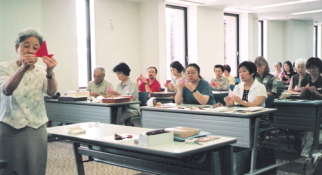 |
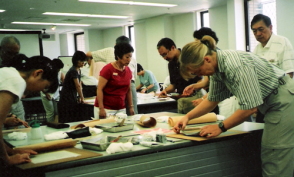 |
| Studying how to fold models. |
Adjustment of papers & Demonstration of lining papers |
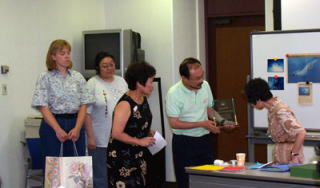 |
Rep. Kiyo Yoshizawa with commemorative plate granted by gOrigami USAh(with the president of Origami USA, Mr. Tony Cheng) |
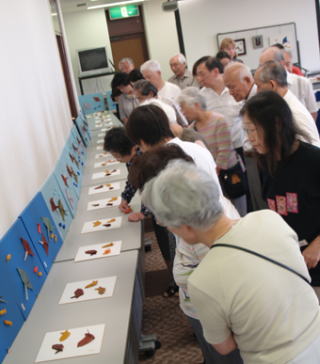 |
Appreciation & Review of models(1)
The final day of this seminar, participants enjoyed looking at their completed fine models. Panels of gThe Sea of Mantash and thick square papers(Shikishi) of g3 forms of Wrenh were lined up beautifully. Although everyone folded with same theme, each model looked so different and unique. Participants carefully listened to every comments from viewers and watched eagerly other participantfs works. |
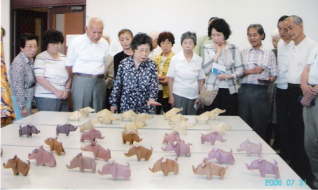 |
Appreciation & Review of models(2)
2 forms of gRazorbackh, Japanese Zodiac sign of the next year, folded with lining handmade Japanese papers. Such cubic models made viewers see each folderfs ability quite clear. |
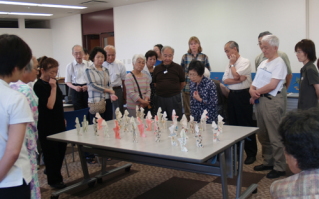 |
Appreciation & Review of models(3)
gJapanese Brideh, folded with lining white and gaily colored handmade Japanese papers. Participants were fascinated with Yoshizawafs Creative Origami creating such a dainty figure with only one paper. Each model had a characteristic of each folder since the ratio of folding line depended on the selection of folders. Using delicate special papers, those would be memorable models for folders with strong attachment. |
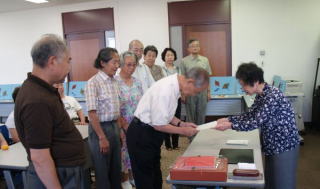 |
After the appreciation and review of models, participants were granted certifications of the seminar. We are looking forward to seeing you all again. |
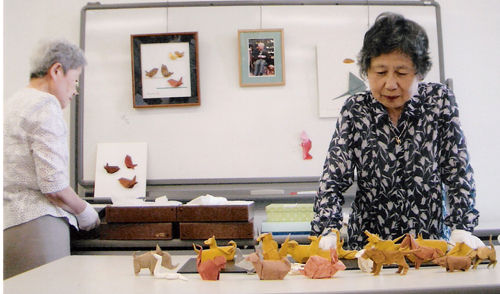 |
The closing event of this seminar was the exhibition of Akira Yoshizawafs models. All participants were delighted to see his models so closely and went back home with content. 12 animals of gJapanese Zodiac Signsh. These models were desirable materials for studying various animalfs forms.
|
